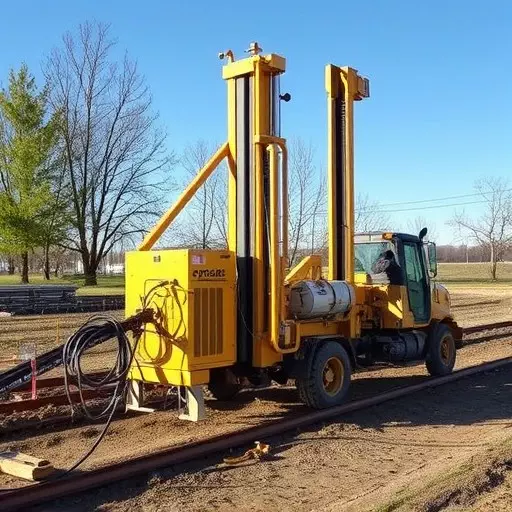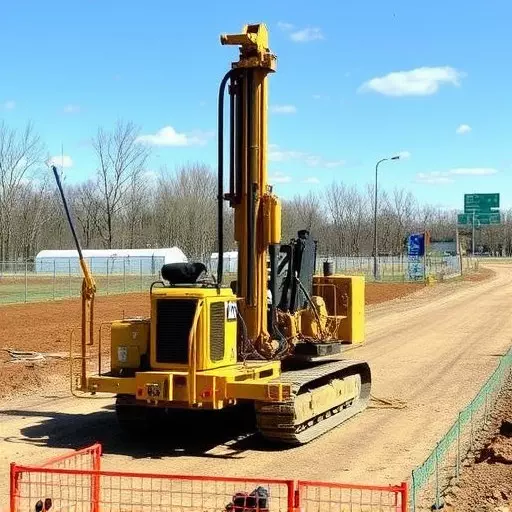Directional boring, or Horizontal Directional Drilling (HDD), is a cutting-edge trenchless technology transforming underground construction in Toledo and beyond. It offers numerous advantages over conventional methods, including precision control, real-time monitoring, and minimal ground disturbance, making it ideal for urban and rural areas. HDD enables efficient installation of utilities like pipelines, cables, and fiber optics with reduced environmental impact, faster completion times, and lower costs. Specialized equipment, meticulous site preparation, advanced sensors, and robust project management ensure successful HDD projects in Toledo, promoting safety, efficiency, and sustainability. Its adoption in ecologically sensitive regions enhances community acceptance while preserving local ecosystems.
Directional boring, or horizontal directional drilling (HDD), is a revolutionary trenchless technology transforming construction and infrastructure projects. This advanced method offers significant advantages over traditional techniques, from reduced environmental impact to faster completion times. In this comprehensive guide, we explore the best practices for successful HDD operations, including tool selection, site preparation, obstacle navigation, project management, and environmental considerations. Discover why Directional Boring Toledo is a game-changer in the industry, revolutionizing how we build beneath the surface.
- Understanding Directional Boring: A Basic Overview
- Advantages of Horizontal Directional Drilling (HDD) Over Traditional Methods
- Essential Tools and Equipment for Accurate Directional Boring
- Site Preparation and Safety Measures Before Commencing HDD
- Techniques for Navigating Obstacles During Drilling Operations
- Best Practices for Project Management and Quality Control
- Environmental Impact and Sustainable Trenchless Technology Solutions
Understanding Directional Boring: A Basic Overview

Directional boring, also known as horizontal directional drilling (HDD), is a revolutionary trenchless technology that has transformed underground construction. This method involves using specialized equipment to create a tunnel beneath the surface, allowing for the installation of utilities like pipelines, cables, or fibers without traditional excavation. By employing directional boring in Toledo and beyond, construction projects can now avoid damaging vulnerable above-ground structures and reduce the risk of accidents associated with open-cut methods.
HDD offers numerous advantages over conventional digging techniques. It is particularly useful for tight spaces and challenging geographical conditions. With precise control and real-time monitoring, operators can navigate around obstructions like buildings, bridges, or underground utilities, making it a versatile solution for urban and rural settings. This technology ensures minimal ground disturbance, expediting project timelines and reducing environmental impact.
Advantages of Horizontal Directional Drilling (HDD) Over Traditional Methods

Horizontal Directional Drilling (HDD) offers numerous advantages over traditional excavation methods like open-cut or backhoe digging. One of the key benefits is its ability to minimize disruption and damage to existing surfaces, making it ideal for urban settings where infrastructure is dense. HDD allows for the installation of utilities such as pipes, cables, and fiber optics beneath the ground without the need for large trenches, thereby reducing construction time and costs significantly.
This trenchless technology also enhances safety by eliminating the risk associated with operating heavy machinery close to sensitive areas like buildings, roads, and buried utilities. The precise control offered by HDD ensures that installations are made with accuracy, minimizing the potential for collateral damage. Additionally, this method is more environmentally friendly as it reduces soil disturbance and water usage, making it a preferred choice in regions where ecological preservation is paramount.
Essential Tools and Equipment for Accurate Directional Boring

When it comes to accurate directional boring, the right tools and equipment are paramount. A top-notch Directional Boring Toledo is an indispensable asset for any professional in this field. These advanced devices offer precise control, allowing operators to steer drills with utmost accuracy, even through intricate underground paths. The Horizontal Directional Drilling (HDD) process relies heavily on these tools to create minimal-disturbance tunnels, making Trenchless Technology a preferred method for many infrastructure projects.
Key components of an optimal setup include advanced transponders, GPS guidance systems, and high-quality drilling rigs. These instruments ensure the drill bit follows the planned route, facilitating smooth operations and reducing potential damage to underground utilities. The use of such sophisticated equipment not only enhances efficiency but also guarantees safety during horizontal directional drilling, a method that has transformed underground construction.
Site Preparation and Safety Measures Before Commencing HDD

Before initiating any directional boring project in Toledo, thorough site preparation and safety assessments are paramount. This initial phase involves meticulous planning to ensure the success and efficiency of the Horizontal Directional Drilling (HDD) process. The site should be cleared of obstructions like trees, utility lines, and underground structures to prevent damage during drilling. Comprehensive surveys are conducted using advanced technology to map out the underground infrastructure, guiding the safe and precise placement of the bore.
Safety is paramount in the world of directional boring. Protective gear and protocols must be implemented to safeguard workers from potential hazards. This includes equipment designed to mitigate risks associated with confined spaces, high-pressure fluids, and the potential for sudden shifts in underground conditions. Regular safety training sessions for all personnel ensure they are prepared to handle any challenges that may arise during the HDD process, emphasizing the importance of adherence to industry standards and best practices in trenchless technology.
Techniques for Navigating Obstacles During Drilling Operations

In directional boring operations, navigating obstacles is a critical aspect that demands meticulous planning and skilled execution. Techniques such as real-time monitoring using advanced sensors and cameras help in identifying and avoiding underground utilities, rocks, and other impediments. These technologies provide precise data on drilling progress, enabling operators to make informed adjustments to the bore path.
Additionally, utilizing specialized equipment designed for horizontal directional drilling (HDD) offers advantages in navigating complex terrains. Trenchless technology allows for the installation of pipelines, cables, or utilities without traditional excavation, minimizing disruptions to the surrounding area. By employing these best practices and innovative tools, directional boring projects can efficiently navigate obstacles, ensuring successful completion while maintaining safety and integrity.
Best Practices for Project Management and Quality Control

When implementing directional boring techniques, such as Horizontal Directional Drilling (HDD), in projects like those carried out by Directional Boring Toledo, robust project management and quality control are paramount. The first step involves meticulous planning that aligns with industry best practices. This includes detailed design and engineering to ensure the safe and efficient navigation of the bore path, taking into account underground utility location and mapping to avoid conflicts. A comprehensive project schedule should be created, with clear milestones and tasks, to keep the operation on track and allow for effective resource allocation. Regular team meetings and updates are crucial to maintain communication and address any emerging challenges promptly.
Quality control measures are integral to guarantee the precision and integrity of the drilling process. Regular inspections at various stages of the project ensure adherence to specifications and industry standards. This includes verifying bore path direction, depth, and deviation limits using advanced technology like total stations or laser-guided systems. Soil sampling and analysis can also provide insights into ground conditions, helping to identify potential issues early on. Additionally, maintaining detailed records of drilling parameters, such as torque, drag, and mud flow rates, enables continuous monitoring and adjustment, ultimately contributing to the successful completion of trenchless projects using Horizontal Directional Drilling or other related technologies.
Environmental Impact and Sustainable Trenchless Technology Solutions

The environmental impact of construction projects has become a significant focus in recent years, and the adoption of trenchless technology, such as horizontal directional drilling (HDD), offers a more sustainable approach to infrastructure development. Directional boring techniques, particularly popular in the Toledo area, allow for the installation of utilities like pipelines, cables, or fiber optics underground without the need for traditional excavation methods. This method minimizes disruption to the surrounding ecosystem, preserving local flora and fauna and reducing the carbon footprint associated with construction.
By utilizing trenchless technology, construction projects can avoid the energy-intensive processes and extensive site preparation required by open-cut excavation. Horizontal directional drilling provides a precise and controlled method of installation, ensuring that utilities are laid down with accuracy, minimizing land clearance, and potentially reducing the need for future maintenance due to its lower impact on the surrounding landscape. This not only contributes to environmental sustainability but also fosters community acceptance of infrastructure upgrades in ecologically sensitive areas.


